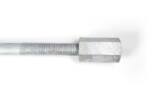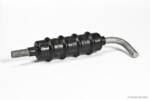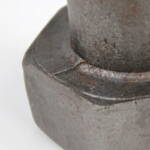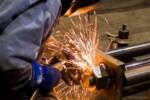Technical FAQs
Fixing Misaligned Anchor Bolts
What do I do if I poured my anchor bolts in the wrong position?This is a common problem, and one that can be very difficult to remedy once the concrete is cured. As with most job-site fixes, the repair method depends on the nature of the problem and when in the construction process it is first noted. The repair method may be different if one bolt is out... Read more
A193B7 Service Temperature
What is the maximum service temperature for A193 Grade B7 bolts?Portland Bolt is often faced with this question, and because there are many conflicting sources online, we decided to do a little research on our own. The resource we found most helpful was ASME B31.1-2012. In this specification, there is a table which shows the maximum allowable stress values in Tension (KSI) for metal temperature.... Read more

Coupling Nut Thread Engagement
How much coupling nut thread engagement is required to achieve the strength of the rod?Unfortunately there appears to be no documented information on how much rod engagement into a coupling nut is required to achieve the strength of the rod or bolt being used with it. Coupling nuts are manufactured to the same ASTM specifications as regular hex nuts, and ASME B18.2.2 provides dimensional specifications for coupling nuts. Standard coupling... Read more
Anchor Bolts Too Low or High
What do I do if I poured my anchor bolts too low or too high?The answer can be found in AISC Design Guide 1,Section 2.11.3: “Anchor rod projections that are too short or too long must be investigated to determine if the correct anchor rods were installed. If the anchor rod is too short, the anchor rod may be projecting below the foundation. If the rod projection is too long,... Read more

Between Anchor Bolt Sleeves
What size anchor bolt sleeve do I use to fit a 1-1/8” diameter anchor bolt?This question is often brought to Portland Bolt’s attention by customers wondering how to install an anchor bolt sleeve with a 1-1/8” diameter rod. This issue arises due to the fact that anchor bolt sleeves are not manufactured in 1-1/8” diameter. We knew of two different solutions, but were left wondering which was the preferred... Read more
Stainless Steel F1554 Anchor Bolts
Do F1554 anchor bolts come in stainless steel?The answer to this question is no. As stated in Section 1.1, the F1554 specification covers various configurations of, “…carbon, carbon boron, alloy, or high-strength alloy steel anchor bolts.” In general terms, for a steel to be considered “stainless” it must contain at least 10.5% chromium as part of its chemical composition and will often... Read more
Galvanizing 8 Pitch Threads
Why won’t Portland Bolt manufacture galvanized bolts above 1-1/2” diameter with 8 TPI thread?Our two main concerns with providing galvanized bolts larger than 1-1/2” diameter with 8 threads per inch is the lack of overtap allowance standards for the mating nut and the potential for premature thread stripping due to the nut oversizing. Overtap Allowances All inch series hot dip galvanized hex nuts, regardless of grade, are tapped... Read more

Die Seams on Headed Bolts
Are die seams allowed on headed bolts?There are several differences between bolts intended for use in construction and more precision fasteners, such those used in an OEM application. One difference for headed bolts is the process in which the head is formed on the bolt and the resulting appearance of the bolts. Larger, construction headed bolts are typically made by hot-forging... Read more
Correcting Anchor Bolt Damage
If my already installed anchor bolts got bent by accident, is it OK to bend them back?The anchor rods in this photo were damaged because they were covered with snow and the equipment operator did not see them. Every situation is different, and we try to not make recommendations where bent anchors are concerned as we feel it is a question better answered by the project engineer, as he/she will be... Read more

Bolt Welding Guidelines
When is it acceptable to weld to bolts, and when it is prohibited?Many grades of bolt gain their strength though a heat treating process, and the addition of heat during welding can adversely alter those strength properties. However, some lower strength grades are easily weldable when manufactured from weldable steel. In general, steel items which have been heat treated for strength should generally not be welded since... Read more
